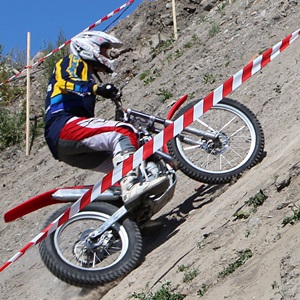Will New Oregon Law Lead to More ATV Injuries for Kids?
Last month, the Oregon Senate passed legislation that allows children of any age to ride off-road motorcycles on public land. On March 12, Senate Bill 238 passed 22-7, with bipartisan support (12 Republicans and 10 Democrats).
The main requirement will be that they meet “rider fit” guidelines from the State Parks and Recreation Department. This includes minimum leg length, brake and grip reach. If it passes through the House, a child under 16 still has to be accompanied by someone 18 or older with a valid all-terrain vehicle operator permit.
This is a classic “slippery slope” debate.
Where do sensible protective actions end and overreaching nanny state laws begin? People in favor of the measure don’t want government making what they feel are decisions best left to parents. But would those same people think they have a right to let their seven-year-old child take a motorcycle down I-5 with their 18-year-old brother on the back?
The point is, there’s room for sensible debate rather than labeling every law aimed at preventing injury as overreaching. Parents absolutely have the right to make their own parenting decisions, but at what point can it be called reckless endangerment?
Then there’s a potential complication arising from an omission in the law. It only stipulates the age of the person supervising a child under seven. What if a parent was unaware that someone else took their child out for some fun?
What matters most is child welfare and when adults make unreasonably dangerous decisions on their behalf, sometimes laws need to be enacted.
In 2011, 57 children under 16 years old died and an estimated 29,000 were seriously injured and sent to an emergency room because of ATVs.
What it all boils down to is this: are children physically and mentally capable of driving ATVs safely and responsibly?
Supporters of the bill are happy because it improves safety with minimum size requirements. But what about the mental requirements not yet met at such an early age?
Last year the American Academy of Pediatrics issued a statement saying that “Simply put, ATVs are dangerous to children” and that they are not “developmentally capable of operating these heavy, complex machines.”
According to data from the U.S. Product Safety Commission, ATV-related deaths for kids under 16 have seen a pretty dramatic decrease in recent years. Deaths peaked from 2003 to 2005 with 153, 182, 162. The last three years recorded (2009-2011) have decreased consecutively: 94, 82, 57. That said, do we need to tempt fate by encouraging really young kids who are not ready to handle deadly machinery?
 Last month, the Oregon Senate passed legislation that allows children of any age to ride off-road motorcycles on public land. On March 12, Senate Bill 238 passed 22-7, with bipartisan support (12 Republicans and 10 Democrats).
Last month, the Oregon Senate passed legislation that allows children of any age to ride off-road motorcycles on public land. On March 12, Senate Bill 238 passed 22-7, with bipartisan support (12 Republicans and 10 Democrats).
The main requirement will be that they meet “rider fit” guidelines from the State Parks and Recreation Department. This includes minimum leg length, brake and grip reach. If it passes through the House, a child under 16 still has to be accompanied by someone 18 or older with a valid all-terrain vehicle operator permit.
This is a classic “slippery slope” debate.
Where do sensible protective actions end and overreaching nanny state laws begin? People in favor of the measure don’t want government making what they feel are decisions best left to parents. But would those same people think they have a right to let their seven-year-old child take a motorcycle down I-5 with their 18-year-old brother on the back?
The point is, there’s room for sensible debate rather than labeling every law aimed at preventing injury as overreaching. Parents absolutely have the right to make their own parenting decisions, but at what point can it be called reckless endangerment?
Then there’s a potential complication arising from an omission in the law. It only stipulates the age of the person supervising a child under seven. What if a parent was unaware that someone else took their child out for some fun?
What matters most is child welfare and when adults make unreasonably dangerous decisions on their behalf, sometimes laws need to be enacted.
In 2011, 57 children under 16 years old died and an estimated 29,000 were seriously injured and sent to an emergency room because of ATVs.
What it all boils down to is this: are children physically and mentally capable of driving ATVs safely and responsibly?
Supporters of the bill are happy because it improves safety with minimum size requirements. But what about the mental requirements not yet met at such an early age?
Last year the American Academy of Pediatrics issued a statement saying that “Simply put, ATVs are dangerous to children” and that they are not “developmentally capable of operating these heavy, complex machines.”
According to data from the U.S. Product Safety Commission, ATV-related deaths for kids under 16 have seen a pretty dramatic decrease in recent years. Deaths peaked from 2003 to 2005 with 153, 182, 162. The last three years recorded (2009-2011) have decreased consecutively: 94, 82, 57. That said, do we need to tempt fate by encouraging really young kids who are not ready to handle deadly machinery?

 Last month, the Oregon Senate passed legislation that allows children of any age to ride off-road motorcycles on public land. On March 12, Senate Bill 238 passed 22-7, with bipartisan support (12 Republicans and 10 Democrats).
Last month, the Oregon Senate passed legislation that allows children of any age to ride off-road motorcycles on public land. On March 12, Senate Bill 238 passed 22-7, with bipartisan support (12 Republicans and 10 Democrats).